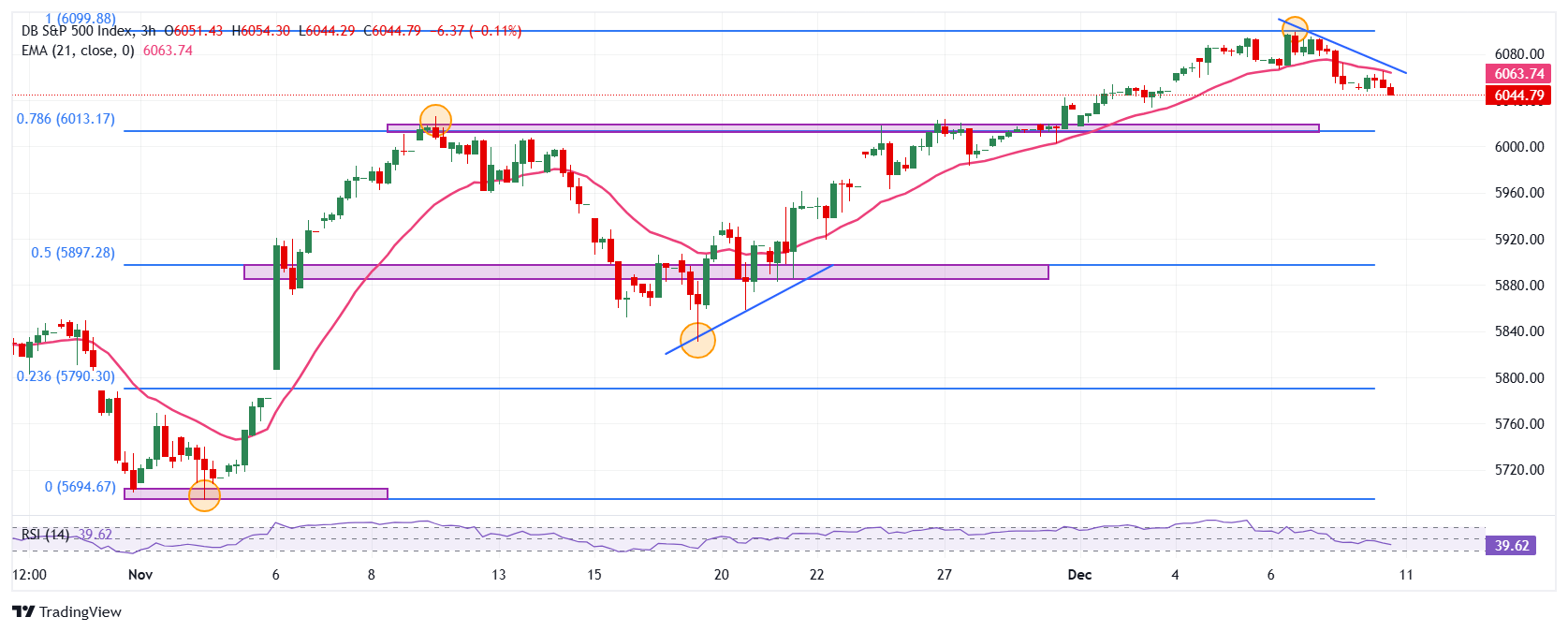- The S&P 500 index fell 0.15% daily, reaching one-week lows.
- Oracle Corporation (ORCL) stock loses 7.70% on the day following the release of its earnings report.
- Super Micro Computer (SMCI) shares fall 6.37%, reaching December 4 lows.
- Investors remain focused on US inflation, which will be released tomorrow.
The S&P 500 hit a daily high of 6,064, where it attracted sellers who drove the stock price to one-week lows not seen since December 3 at 6,047. At the time of writing, the S&P 500 is trading above 6,045, down 0.15% today.
Super Micro Computer and Oracle Corporation keep the S&P 500 in the negative zone
Super Micro Computer (SMCI) shares fell 6.37% on Tuesday, trading at $41.32 at the time of writing. Fears about SMCI’s exclusion from the Nasdaq 100 technology index persist as the company has filed its financial reports late. SMCI CEO Charles Liang stressed his confidence that the company’s shares will not be delisted in the next index rebalancing scheduled for December 13.
On the other hand, Oracle Corporation (ORCL) shares fell 7.70% today, currently trading at $175.60 and reaching the lows of November 5 at $171.06, after releasing its quarterly report. ORCL posted revenue of $14.1 billion, below the expected $14.12 billion. Likewise, the company achieved earnings per share of $1.47, below the $1.48 expected by analysts, disappointing investors.
Investors will focus on the US Consumer Price Index. The market consensus projects the year-on-year CPI for November at 2.7%, slightly higher than the 2.6% recorded in October.
Levels to consider in the S&P 500
The S&P 500 reacted lower into short-term resistance given the all-time high reached on December 6 at 6,098. The first support zone is at 5,830, the low of November 19. The next key support is at 5,694, the November 4 pivot point.
S&P 500 3-hour chart

The S&P 500 FAQs
The S&P 500 is a widely followed stock index that measures the performance of 500 public companies and is considered a broad measure of the US stock market. The influence of each company in the calculation of the index is weighted based on market capitalization. This is calculated by multiplying the number of listed shares of the company by the share price. The S&P 500 Index has achieved impressive returns: $1.00 invested in 1970 would have produced a return of almost $192.00 in 2022. The average annual return since its inception in 1957 has been 11.9%.
Companies are selected by committee, unlike other indices where they are included based on established standards. Still, they must meet certain eligibility criteria, the most important of which is market capitalization, which must be equal to or greater than $12.7 billion. Other criteria are liquidity, domicile, market capitalization, sector, financial viability, listing time, and representation of the sectors of the United States economy. The nine largest companies in the index represent 27.8% of the index’s market capitalization.
There are several ways to trade the S&P 500. Most retail brokers and spread betting platforms allow traders to use Contracts for Difference (CFDs) to place bets on price direction. In addition, you can buy index funds, mutual funds and exchange-traded funds (ETFs) that track the price of the S&P 500. The most liquid of the ETFs is the London Stock Exchange ETF. The most liquid of the ETFs is State Street Corporation’s SPY. The Chicago Mercantile Exchange (CME) offers futures contracts on the index and the Chicago Board of Options (CMOE) offers options, as well as ETFs, inverse ETFs, and leveraged ETFs.
There are many factors that drive the S&P 500, but primarily it is the aggregate performance of its component companies, revealed in their quarterly and annual earnings reports. US and global macroeconomic data also contribute, influencing investor sentiment, which if positive, drives earnings. The level of interest rates, set by the Federal Reserve (Fed), also influences the S&P 500, as it affects the cost of credit, on which many companies largely depend. Therefore, inflation can be a determining factor, as well as other parameters that influence the decisions of the Federal Reserve.
Source: Fx Street
I am Joshua Winder, a senior-level journalist and editor at World Stock Market. I specialize in covering news related to the stock market and economic trends. With more than 8 years of experience in this field, I have become an expert in financial reporting.







